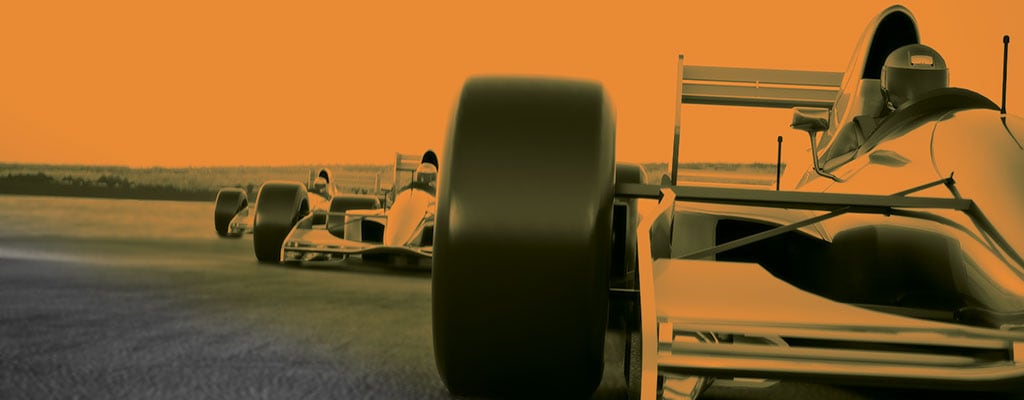

Race teams always try new ways to bend the laws of physics, so showing the world what our parts can manage is great for TE as a whole.
With 15 years of experience in the global motorsport industry, Paul specializes in professional motorsport electrical design and implementation, for both data and power distribution. As Global Product Manager for the DEUTSCH Autosport range of connectors, Paul has developed the TE DEUTSCH products from a small demand from Formula 1 to the market leader in interconnection solutions on all professional racing series. As TE continues to expand its racing presence, the insights and voice of Paul Webb continue to add value to the conversation of this growing focus, as he has been working with and watching these products evolve for many years.
How did you get involved and interested in engineering?
I suppose much like other people in this industry I liked taking things apart to see how they worked. Occasionally I managed to put it back together again in the same order and that’s how I started to learn. I also discovered motorsport at a suitably youthful age when I watched the Italian Grandprix from Monza on our neighbor’s color television. Black and white just didn't really do the exciting sport enough justice, and my interest started to point at vehicles rather than random mechanical items.
What would you consider your specialty and why?
Due to the nature of what we do at TE and my experience, the electrical elements of the racecar are where my knowledge is strongest. However you can not work around racing people without absorbing other elements of racecar design and setup. No human on earth can know everything about car design, and we have many series to support so I’m always learning new things.
What originally drove you to the motorsport industry with TE?
It is actually the only industry I have ever been involved with in my fifteen years with the company. I have had a few different roles, but my passion for motorsport certainly makes getting out of bed on a gloomy Monday morning much easier!
What kind of advancements do you think have most affected the industry?
Motorsport is a living beast and change happens all the time. New ideas and solutions often happen over a single race weekend! New materials and amazing design solutions have allowed huge evolution, so teams can refine their vehicles to levels only dreamed about a few years ago. Some of the F1 teams take 3D printers to the track now to alter aerodynamic pieces overnight. Computing power has changed what can be done at the track and the race team factories simultaneously. It's like something from a science fiction film, and this can only continue in the next few years.
Where do you see the future of motorsport in the next few years?
The world points to low carbon emissions and more efficiency to be at the forefront of racing rather than an excess of cylinders and noise being the main attraction. However, fans still want to see exciting racing technologies, like fuel flow monitoring, allow the sports authorities to encourage a range of technologies that can compete with each other. An examples of this is the LMP1 (Le Mans prototype series) where turbo diesel with flywheels competes with gasoline and super capacitors with gasoline and battery storage. The 2015 race finished with these different technologies still fighting it out into the last hour. Just when you think you are getting on top of a series, a new set of regulations or innovation turns conventional thinking on its head – which is why we enjoy working with this industry.

Formula E Racing Makes An Ideal Real-World Platform For Developing New Technologies
-
By Paul Webb, Autosport Sales and Marketing Manager - July 2016
Today, Formula E racing is an important platform for developing battery technology and electric powertrains... (published in ECN magazine August 2016)
Saving Weight In Interconnections In Autosport
-
By Paul Webb, Autosport Sales and Marketing Manager - June 2016
Interconnection technology continues to advance, offering new level of weight savings for autosport applications...
Need help with your Autosport project?


Race teams always try new ways to bend the laws of physics, so showing the world what our parts can manage is great for TE as a whole.
With 15 years of experience in the global motorsport industry, Paul specializes in professional motorsport electrical design and implementation, for both data and power distribution. As Global Product Manager for the DEUTSCH Autosport range of connectors, Paul has developed the TE DEUTSCH products from a small demand from Formula 1 to the market leader in interconnection solutions on all professional racing series. As TE continues to expand its racing presence, the insights and voice of Paul Webb continue to add value to the conversation of this growing focus, as he has been working with and watching these products evolve for many years.
How did you get involved and interested in engineering?
I suppose much like other people in this industry I liked taking things apart to see how they worked. Occasionally I managed to put it back together again in the same order and that’s how I started to learn. I also discovered motorsport at a suitably youthful age when I watched the Italian Grandprix from Monza on our neighbor’s color television. Black and white just didn't really do the exciting sport enough justice, and my interest started to point at vehicles rather than random mechanical items.
What would you consider your specialty and why?
Due to the nature of what we do at TE and my experience, the electrical elements of the racecar are where my knowledge is strongest. However you can not work around racing people without absorbing other elements of racecar design and setup. No human on earth can know everything about car design, and we have many series to support so I’m always learning new things.
What originally drove you to the motorsport industry with TE?
It is actually the only industry I have ever been involved with in my fifteen years with the company. I have had a few different roles, but my passion for motorsport certainly makes getting out of bed on a gloomy Monday morning much easier!
What kind of advancements do you think have most affected the industry?
Motorsport is a living beast and change happens all the time. New ideas and solutions often happen over a single race weekend! New materials and amazing design solutions have allowed huge evolution, so teams can refine their vehicles to levels only dreamed about a few years ago. Some of the F1 teams take 3D printers to the track now to alter aerodynamic pieces overnight. Computing power has changed what can be done at the track and the race team factories simultaneously. It's like something from a science fiction film, and this can only continue in the next few years.
Where do you see the future of motorsport in the next few years?
The world points to low carbon emissions and more efficiency to be at the forefront of racing rather than an excess of cylinders and noise being the main attraction. However, fans still want to see exciting racing technologies, like fuel flow monitoring, allow the sports authorities to encourage a range of technologies that can compete with each other. An examples of this is the LMP1 (Le Mans prototype series) where turbo diesel with flywheels competes with gasoline and super capacitors with gasoline and battery storage. The 2015 race finished with these different technologies still fighting it out into the last hour. Just when you think you are getting on top of a series, a new set of regulations or innovation turns conventional thinking on its head – which is why we enjoy working with this industry.

Formula E Racing Makes An Ideal Real-World Platform For Developing New Technologies
-
By Paul Webb, Autosport Sales and Marketing Manager - July 2016
Today, Formula E racing is an important platform for developing battery technology and electric powertrains... (published in ECN magazine August 2016)
Saving Weight In Interconnections In Autosport
-
By Paul Webb, Autosport Sales and Marketing Manager - June 2016
Interconnection technology continues to advance, offering new level of weight savings for autosport applications...
